Recent Posts
Water Damage Restoration: What to Do When a Leak or Flood Strikes
3/11/2025 (Permalink)
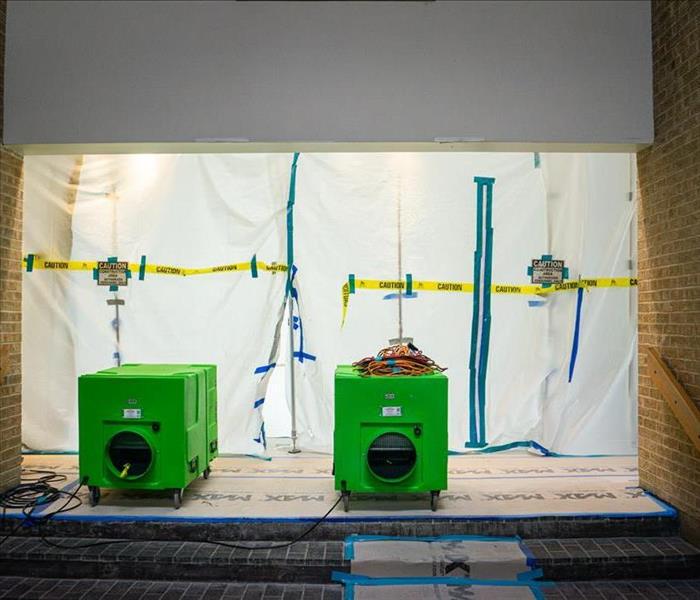 Team Shaw equipment at job site
Team Shaw equipment at job site
Water damage can happen at any time, whether from a burst pipe, a leaking roof, or severe flooding. For homeowners and business owners in Lake Conroe, Cleveland, and Magnolia, taking immediate action is crucial to preventing long-term structural damage and costly repairs. Understanding the right steps to take can help you minimize the impact of water damage and ensure a faster recovery.
Common Causes of Water Damage
Water damage can result from several different sources, including:
- Plumbing Issues: Burst pipes, faulty water heaters, and leaking appliances are among the most common causes of water damage in homes and businesses.
- Severe Weather: Heavy rains and flash floods can overwhelm drainage systems and cause water intrusion.
- Roof Leaks: Damaged or aging roofs can allow rainwater to seep into walls, ceilings, and attics.
- Foundation Cracks: Over time, small foundation cracks can allow water to enter basements and crawl spaces, leading to mold and structural issues.
- Sewer Backups: Blocked or overwhelmed sewer lines can push wastewater back into homes, requiring professional cleanup.
What to Do When Water Damage Occurs
Ensure Safety First
If flooding or water damage occurs, check for potential electrical hazards before entering the affected area. Avoid standing water if you suspect electrical outlets or appliances are submerged.
Stop the Water Source
If possible, turn off the main water supply to prevent further damage. If the water is coming from a leak in the roof, use a tarp to minimize water intrusion until repairs can be made.
Move Valuables to a Dry Area
Quickly relocate furniture, electronics, and important documents to prevent further damage. Place aluminum foil or wooden blocks under furniture legs to prevent water absorption.
Start Water Extraction
If it’s safe to do so, remove standing water using a wet/dry vacuum, towels, or buckets. The longer water sits, the higher the risk of mold growth and structural damage.
Call a Professional Restoration Company
Water damage is best handled by professionals who have the expertise and equipment to properly dry, clean, and restore your property. SERVPRO® of Lake Conroe, Cleveland, and Magnolia offers 24/7 emergency response to mitigate water damage quickly.
How SERVPRO® of Lake Conroe, Cleveland, and Magnolia Can Help
Our team specializes in professional water damage restoration, using industry-leading techniques such as:
- Advanced Water Extraction & Drying – We use powerful pumps and industrial-grade dehumidifiers to remove excess water and dry affected areas thoroughly.
- Mold Prevention & Remediation – Our team ensures that all moisture is properly eliminated to prevent mold growth.
- Structural Repairs – We restore damaged drywall, flooring, and ceilings to their preloss condition.
- Insurance Assistance – We work directly with insurance providers to streamline the claims process and reduce your stress.
If your home or business experiences water damage, don’t wait—call SERVPRO® of Lake Conroe, Cleveland, and Magnolia for fast, professional restoration services. Our team is ready 24/7 to help you recover quickly and effectively.
The Hidden Dangers of Fire Damage and How to Recover
3/11/2025 (Permalink)
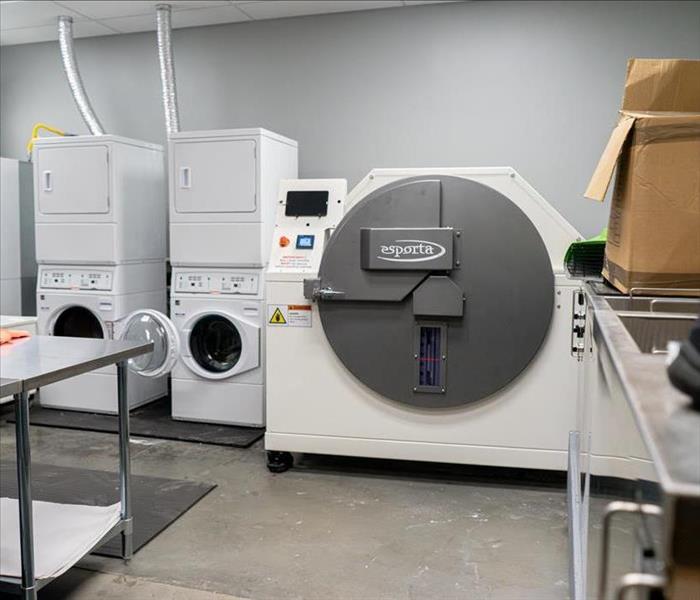 Content restoration equipment at the Shaw HQ
Content restoration equipment at the Shaw HQ
A fire can be one of the most devastating events for any home or business owner. Beyond the immediate damage caused by flames, smoke and soot can leave long-lasting effects that require professional restoration. SERVPRO® of Lake Conroe, Cleveland, and Magnolia specializes in fire damage restoration, helping property owners rebuild and restore their spaces quickly.
The Dangers of Fire Damage Beyond the Flames
Even after a fire is extinguished, the damage continues. Here’s what property owners need to be aware of:
- Smoke Residue: Smoke particles can settle deep into walls, carpets, and furniture, creating persistent odors and potential respiratory hazards.
- Soot Corrosion: Soot from fires is highly acidic and can cause permanent damage to surfaces, including metal, glass, and electronics.
- Water & Chemical Damage: The water used to extinguish the fire can cause additional damage, leading to mold growth if not properly dried.
- Weakened Structural Integrity: Fire can weaken the structure of a home or business, making it unsafe to enter until properly assessed.
What to Do After a Fire
Ensure Everyone’s Safety
Once the fire is out, wait for clearance from fire officials before re-entering the property. Smoke inhalation and structural instability can pose serious risks.
Document the Damage
Take photos and make a list of damaged items for insurance claims. This will help speed up the process of getting financial assistance for repairs.
Avoid Cleaning Soot Yourself
Soot spreads easily and can become embedded in fabrics and porous materials. Using improper cleaning methods can cause more harm than good.
Call a Professional Fire Damage Restoration Service
SERVPRO® of Lake Conroe, Cleveland, and Magnolia has the expertise to clean up fire damage, remove smoke odors, and restore your property efficiently.
Our Fire Damage Restoration Services
- Soot and Smoke Removal: Using specialized techniques, we remove all traces of soot from walls, ceilings, and surfaces.
- Odor Elimination: We use industrial-grade air scrubbers and ozone treatments to eliminate smoke odors.
- Structural Repairs: From drywall replacement to full reconstruction, we restore damaged areas to their pre-fire condition.
- Content Cleaning: We clean and restore salvageable furniture, electronics, and personal items affected by smoke.
Recovering from a fire can feel overwhelming, but SERVPRO® of Lake Conroe, Cleveland, and Magnolia is here to help. Contact us for fast, professional fire damage restoration services.
Why Commercial Properties Need Professional Cleaning and Restoration Services
3/11/2025 (Permalink)
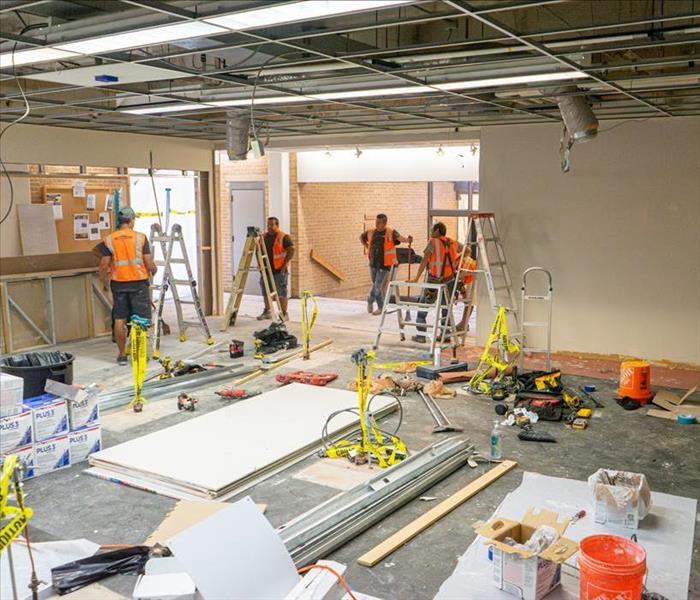 Restoration job at local university
Restoration job at local university
Commercial buildings require regular maintenance to remain safe, clean, and operational. From daily wear and tear to unexpected disasters like water leaks or fire damage, businesses need a trusted restoration partner. SERVPRO® of Lake Conroe, Cleveland, and Magnolia offers professional cleaning and restoration services tailored for commercial properties.
Common Challenges for Commercial Properties
- High Foot Traffic Wear: Office buildings, retail stores, and hotels experience heavy foot traffic, leading to dirt buildup and potential damage to flooring.
- Water & Plumbing Issues: Leaks from restrooms, kitchens, or HVAC systems can cause unseen water damage, leading to mold and structural deterioration.
- Fire Hazards: Electrical issues, kitchen fires, and accidents can lead to fire damage, requiring specialized restoration.
- Indoor Air Quality Concerns: Dust, allergens, and poor ventilation can create an unhealthy environment for employees and customers.
SERVPRO® Commercial Services
- Deep Cleaning: From carpets to HVAC systems, we provide top-to-bottom cleaning services to maintain a professional work environment.
- Water & Fire Damage Restoration: Whether dealing with burst pipes or fire damage, we respond quickly to minimize downtime.
- Mold Remediation: If moisture problems arise, we handle mold removal and prevention to keep your space safe.
- Disinfection & Sanitization: We offer professional-grade cleaning services for offices, healthcare facilities, and industrial spaces.
For commercial properties in Lake Conroe, Cleveland, and Magnolia, having a trusted restoration partner is essential. Contact SERVPRO® of Lake Conroe, Cleveland, and Magnolia to keep your business clean, safe, and ready for operation.
Understanding Flash Floods
1/17/2024 (Permalink)
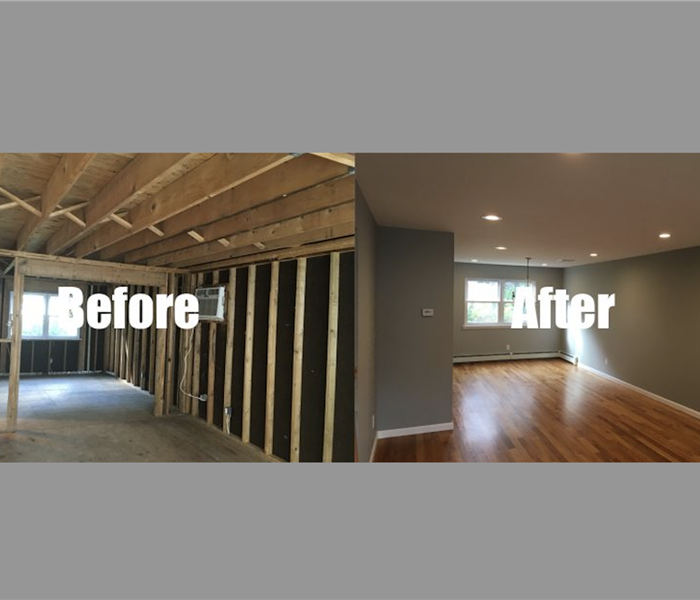 Flash floods are great examples of Mother Nature's fury.
Flash floods are great examples of Mother Nature's fury.
Flash floods are great examples of Mother Nature's fury, capable of causing significant damage within minutes. As experts specializing in water damage cleanup and restoration, we want to equip you with essential knowledge about flash floods and vital preparation measures in this article.
Understanding Flash Floods
Flash floods are abrupt, rapid floods that occur within six hours of heavy rainfall or other causative factors like dam breakage, landslide, or sudden drainage of water bodies in a typically dry area. They can roll boulders, uproot trees, destroy buildings, and carry away cars, swiftly altering the landscape.
Flash Flood Risk Factors
Topography, soil conditions, rainfall intensity, and duration are key risk factors. Urban areas are especially susceptible due to concrete surfaces and complex drainage systems.
Safety Tips for Flash Floods
Being adequately prepared and informed reduces risk during a flash flood dramatically. Here are some safety pointers:
- Stay Informed
Keep an eye on weather updates and flood alerts from local authorities.
- Know Your Area
Familiarize yourself with your local topography and flood zones. This knowledge will let you understand how quickly and severely you could be affected.
- Prepare an Emergency Kit
This kit should have essentials like water, food, medication, a flashlight, a battery-powered radio, and important documents.
- Avoid Floodwaters
Don't attempt to walk or drive through floodwaters. It's hard to estimate the depth or the current's power.
- Evacuation Planning
Plan evacuation routes that lead to higher ground. If authorities advise evacuation, do so immediately.
Flash Flood Cleanup and Restoration – Trust the SERVPRO® Experts
When a flash flood hits, the resultant water damage can be overwhelming. Acting swiftly is critical to minimize loss and ensure quicker restoration. That's where we come in.
Our team of experts at SERVPRO of Lake Conroe is ready to act fast with advanced equipment and techniques. We will expedite the water removal process, dry and clean the areas, restore items, and perform necessary repairs to bring your property back to its pre-flood condition.
Remember, understanding flash floods and the measures needed to safeguard against them can protect your property and save lives. Stay informed, stay prepared, and when the storm subsides, our SERVPRO® team is here to make it "Like it never even happened."
Clearing the Air: The Role of Deodorization in Fire Damage Restoration
12/15/2023 (Permalink)
After a fire, the visible damage is evident, but the lingering odors can be equally distressing. Let's explore why deodorization is an essential step in the restoration process and how it can make a significant difference in your home's recovery.
Understanding the Impact of Smoke Odor
When a fire occurs, it leaves behind not only charred remnants but also a pervasive, stubborn smoke odor. This odor can penetrate porous surfaces, materials, and even HVAC systems, making it challenging to remove. Smoke odors are not only unpleasant but can also pose health risks, making their elimination paramount.
The Importance of Prompt Deodorization
Lingering smoke odors may contain harmful particles and chemicals that can adversely affect your health. Proper deodorization reduces these risks, creating a healthier living environment.
Smoke odors can also decrease the resale value of your home and make it less appealing to potential buyers. Deodorization is a smart investment that helps maintain or even increase your property's value.
The Deodorization Process
- Assessment: Our trained professionals start by assessing the extent of smoke odor damage. This step is crucial to determine the appropriate deodorization methods.
- Cleaning: Thorough cleaning is essential to remove soot and other residues that may be contributing to the odor problem.
- Ozone Treatment: Ozone generators can neutralize odor molecules, effectively eliminating the smell. These generators should be used by trained professionals to ensure safety and effectiveness.
- Thermal Fogging: This process involves using a heated fog to penetrate and neutralize odors in hard-to-reach areas.
- Sealants: In some cases, sealing surfaces can prevent odors from re-emerging, providing long-term protection.
- HVAC Cleaning: Smoke odors can infiltrate your HVAC system, so it's essential to clean and deodorize the ductwork.
Deodorization is a critical aspect of fire damage restoration, one that should not be overlooked. Its impact on your health and property value cannot be overstated. When facing the aftermath of a fire, professional deodorization can make your home safe, comfortable, and inviting once more.
SERVPRO® of Lake Conroe is here to assist you throughout the fire damage restoration process, including comprehensive deodorization. If you're in need of expert guidance and assistance, don't hesitate to contact our local SERVPRO® professionals. We're here to help you reclaim your home and your peace of mind.
What To Do If You Have Mold in Your Commercial Kitchen
11/9/2023 (Permalink)
Running a successful restaurant involves many challenges, and one that often goes overlooked is mold management in your kitchen. Mold can thrive in humid climates like Lake Conroe, Texas, and addressing it is vital to maintain a clean, safe, and efficient kitchen environment. In this blog, we'll delve into crucial strategies to help you effectively deal with mold issues in your restaurant kitchen.
Understanding the Impact of Mold
Mold can have a significant impact on both the appearance and functionality of your restaurant kitchen. In a high-humidity environment like Lake Conroe, mold can grow on various surfaces, including walls, ceilings, and even food storage areas. It's not only unsightly but also poses a risk to food safety and customer satisfaction. To tackle mold effectively, consider the following strategies:
1. Regular Inspections
One of the first steps in mold management is implementing a consistent inspection routine. Regularly check for signs of moisture issues, such as water leaks, condensation, or dampness, especially around sinks, dishwashers, and refrigerators. Early detection is key to addressing mold problems promptly.
2. Proper Ventilation
Ensure your kitchen is adequately ventilated to minimize moisture buildup. Effective ventilation can be achieved through the use of exhaust fans and opening windows when necessary to promote airflow. Additionally, ensure that your ventilation systems, including ducts and vents, are cleaned and well-maintained to prevent mold growth within them.
3. Regular Cleaning and Maintenance
Develop a comprehensive cleaning schedule for your kitchen, with a focus on high-humidity areas like dishwashing stations and sinks. Mold can flourish in neglected corners and hidden spaces, so pay close attention to all surfaces. Consider using mold-resistant materials when renovating or updating your kitchen, especially in areas prone to moisture.
4. Promptly Address Water Leaks
Water leaks and plumbing issues are common culprits behind mold growth. Swiftly address any leaks to prevent mold from taking hold. Regularly inspect your restaurant's roof, windows, and doors for potential entry points for water intrusion and address them promptly to maintain a mold-free environment.
5. Control Humidity
Invest in dehumidifiers for areas prone to high humidity, such as walk-in coolers, to maintain humidity levels below 50%. Your HVAC system should also be well-maintained and equipped to control indoor humidity effectively, helping to create an environment less conducive to mold growth.
6. Educate Your Staff
Your kitchen staff plays a vital role in mold prevention. Train them to recognize signs of mold or moisture issues and encourage them to report any concerns promptly. Implement strict cleanliness and hygiene protocols to prevent mold-contaminated food from reaching your customers.
Maintaining a mold-free restaurant kitchen in Lake Conroe is essential for the success and reputation of your restaurant. By diligently implementing these mold prevention measures and maintaining a clean, dry environment, you can uphold the highest standards of food safety and customer satisfaction. Remember that prevention is the key to success in managing mold in your restaurant kitchen. Should you ever encounter mold problems that are beyond your control, our local SERVPRO® of Lake Conroe team is here to assist you with professional mold remediation services. Stay proactive and continue serving your customers with confidence!
Why Disinfection After Water Damage Is Important
10/18/2023 (Permalink)
 Disinfection after a water loss is crucial to protect your property after water damage.
Disinfection after a water loss is crucial to protect your property after water damage.
Water damage is a distressing experience for any homeowner in the Lake Conroe area, where heavy rains and flooding are common occurrences. Apart from the visible damage to your property, water damage can also introduce other hazards due to the potential growth of harmful microorganisms. In this blog, we will explore the importance of disinfection after water damage and provide you with effective techniques and products to safeguard your home and family.
Understanding the Need for Disinfection
Water damage can create the perfect breeding ground for bacteria, viruses, and mold. Even after visible water is removed, residual moisture can lead to microbial growth, posing risks to your property. Disinfection is a crucial step to ensure your home is safe and healthy after water damage.
Effective Disinfection Techniques
Cleaning and Removal of Debris:
Before disinfection, ensure that all debris, mud, and contaminated materials are removed from your property. This step is essential to allow disinfectants to work effectively.
Use of EPA-Registered Disinfectants:
When choosing disinfectants, opt for those registered with the Environmental Protection Agency (EPA). These products have been tested and approved for their effectiveness against a wide range of pathogens.
Manual Cleaning and Disinfecting:
For non-porous surfaces like countertops and appliances, manually clean and disinfect with appropriate products. Follow manufacturer instructions for dilution and contact time.
Fogging and Spraying:
In cases of extensive water damage, consider professional fogging or spraying services. These methods can effectively disinfect large areas and hard-to-reach places.
HVAC System Cleaning:
Don't forget to clean and disinfect your HVAC system, as it can circulate contaminants throughout your home. Professional HVAC cleaning can be essential for maintaining indoor air quality.
Recommended Disinfection Products
Chlorine-based Disinfectants: Effective against a broad spectrum of pathogens, chlorine-based disinfectants are commonly used for water damage restoration.
Hydrogen Peroxide-based Disinfectants: These are less toxic and can be an excellent choice for disinfecting surfaces without leaving harmful residues.
Professional Disinfection Services: Consider hiring professional water damage restoration companies like SERVPRO® for thorough disinfection using advanced equipment and techniques.
Safety Precautions
Always wear appropriate PPE, including gloves and masks, when handling disinfectants. Ensure proper ventilation during and after disinfection to minimize exposure to fumes.
Disinfection after water damage is a critical step to protect your property and the people inside it. Using effective techniques and EPA-registered disinfectants can make a significant difference in preventing microbial growth. While DIY cleaning and disinfection are possible for small-scale damage, for extensive water damage, it's best to rely on professional services like SERVPRO® to ensure thorough and safe disinfection.
For expert assistance with water damage restoration and comprehensive disinfection in the Lake Conroe area, contact SERVPRO® today. We're here to help you restore your home and peace of mind.
Protecting Your Business in Southern Texas Against Storm-Related Disruptions
9/26/2023 (Permalink)
Running a business in Southern Texas brings numerous opportunities, but it also comes with the responsibility of preparing for the region's unpredictable weather patterns. From hurricanes to heavy rainfall, storm-related disruptions can have a significant impact on your business operations. In this blog, we'll explore practical strategies to safeguard your business from storm-related disruptions, ensuring continuity and minimizing potential losses.
Understanding Southern Texas' Storm Challenges for Businesses
Southern Texas is susceptible to various storm-related challenges, including tropical storms, hurricanes, heavy rains, and flooding. These weather events can lead to power outages, property damage, supply chain interruptions, and more. Businesses need to be prepared to navigate these challenges and maintain operations even in the face of adverse weather.
Develop a Comprehensive Emergency Plan
Creating an emergency plan tailored to your business is essential. This plan should include protocols for evacuation, employee safety, communication, and business continuity. Assign roles and responsibilities to key employees to ensure a swift and coordinated response during storm-related disruptions.
Establish Remote Work Capabilities
Incorporate remote work capabilities into your business operations. Cloud-based systems and remote communication tools allow employees to work from home during storms or other disruptions. This flexibility can help your business continue functioning even if physical access to the office is limited.
Protect Data and Documents
Back up crucial business data and documents to secure cloud storage. In the event of property damage or power outages, this practice ensures that your business-critical information remains accessible. Consider having physical copies stored in a safe location as well.
Fortify Your Physical Location
If your business has a physical storefront or office, take steps to storm-proof the property. Install storm shutters or reinforce windows and doors to protect against wind and debris. Additionally, elevate electrical equipment and important machinery to prevent flood damage.
Maintain Communication Channels
Open and reliable communication is paramount during storm-related disruptions. Ensure you have multiple communication channels in place to reach employees, customers, and suppliers. Use social media, email, text messages, and other platforms to keep stakeholders informed.
Build Relationships with Suppliers
Establish strong relationships with your suppliers and vendors. Discuss contingency plans for supply chain disruptions caused by storms or other emergencies. Having alternative suppliers or backup plans in place can prevent delays in your business operations.
Invest in Business Interruption Insurance
Consider obtaining business interruption insurance that covers losses incurred due to storm-related disruptions. This insurance can provide financial support to help you recover lost income, cover ongoing expenses, and facilitate the resumption of normal business operations.
Protecting your business from storm-related disruptions in Southern Texas requires strategic planning and proactive measures. Developing an emergency plan, enabling remote work, safeguarding data, fortifying your physical location, maintaining communication channels, nurturing supplier relationships, and investing in business interruption insurance are all crucial steps. By implementing these strategies, your business can better weather the storms, ensuring continuity, and minimizing potential losses.
Fire Safety in the Workplace: A Comprehensive Guide to Preparing Your Business for Potential Fires
8/16/2023 (Permalink)
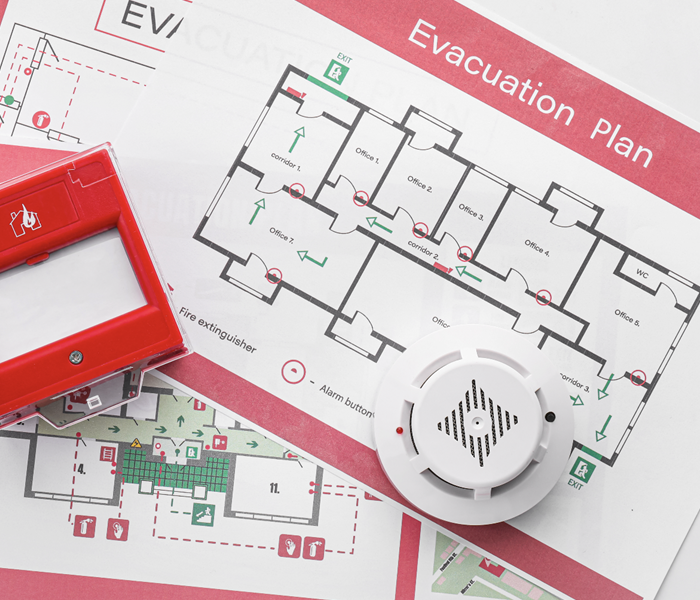 Have a evacuation plan in place to reduce the risk of injury in your business.
Have a evacuation plan in place to reduce the risk of injury in your business.
Fires are unpredictable and can have devastating consequences for businesses. From property damage to financial losses and potential harm to employees and customers, the impact of a fire can be far-reaching. That's why it's crucial for business owners to take proactive measures to prepare for a fire and minimize the risks associated with such an event. In this blog post, we will provide you with a step-by-step guide on how to prepare your business for a fire, ensuring the safety of everyone involved and the continuity of your operations.
Conduct a Fire Risk Assessment
Start by assessing the fire risks specific to your business and premises. Identify potential ignition sources, flammable materials, and areas of concern. Evaluate your emergency evacuation routes, fire alarms, fire extinguishers, and any other fire safety equipment. A comprehensive fire risk assessment will serve as the foundation for your fire preparedness plan.
Develop a Fire Safety Plan
Based on the findings of your fire risk assessment, create a detailed fire safety plan for your business. Include information on emergency procedures, evacuation routes, assembly points, and designated roles and responsibilities for employees during a fire. Ensure the plan is easily accessible to all employees and conduct regular training sessions to familiarize them with the procedures.
Install and Maintain Fire Safety Equipment
Ensure that your business is equipped with appropriate fire safety equipment, including smoke detectors, fire extinguishers, fire sprinklers, and fire blankets. Regularly inspect and maintain this equipment to ensure it is fully operational. Consider partnering with a professional fire safety company to conduct inspections and perform necessary maintenance.
Implement Fire Prevention Measures
Put preventive measures in place to reduce the risk of fire in your business. This can include proper storage and handling of flammable materials, regular equipment maintenance and inspection, and implementing smoking policies in designated areas. Educate your employees about fire prevention measures and encourage them to report any potential fire hazards.
Develop an Emergency Communication Plan
Communication is crucial during a fire emergency. Establish a clear and efficient communication plan that includes methods of notifying employees, emergency services, and relevant stakeholders. Designate individuals responsible for initiating emergency communications and ensure they are trained on the protocols.
Conduct Regular Fire Drills
Regularly practice fire drills with your employees to ensure they are familiar with evacuation routes and procedures. These drills will help identify any gaps or areas for improvement in your fire safety plan. After each drill, conduct a debriefing session to discuss any issues and make necessary adjustments to your plan.
Review and Update Your Fire Preparedness Plan
Your fire preparedness plan should be a living document that is regularly reviewed and updated. As your business evolves or as regulations change, ensure that your plan reflects these updates. Keep abreast of the latest fire safety practices and protocols to ensure that your business remains prepared for any fire-related event.
By following these steps and prioritizing fire preparedness, you can significantly reduce the risks associated with a fire and increase the safety of your business and everyone within it. A well-prepared business will not only protect lives and property but will also be better equipped to recover and resume operations in the event of a fire. Remember, fire preparedness is an ongoing effort that requires regular attention and updates to ensure its effectiveness.
Defending Against Water Damage: Effective Strategies for Preventing Water Loss
7/20/2023 (Permalink)
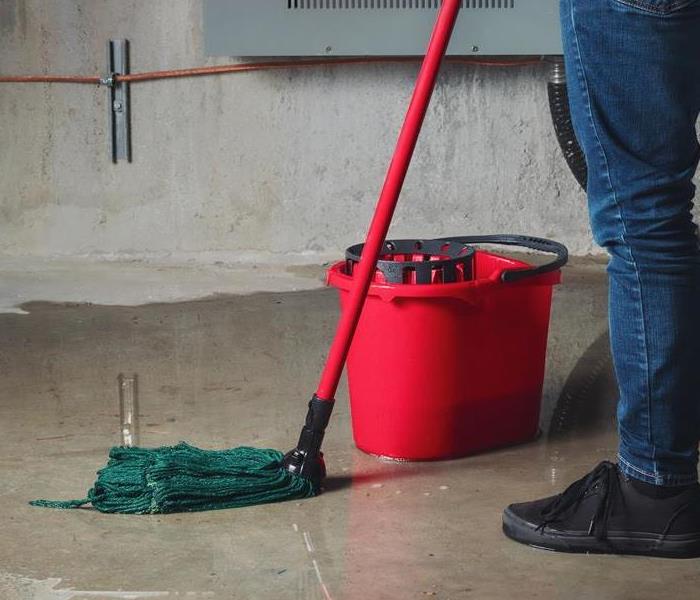 Preventing a water loss can be hard. Be prepared is key to ensuring your home and property is safe.
Preventing a water loss can be hard. Be prepared is key to ensuring your home and property is safe.
Water damage can be a costly and disruptive ordeal for any property owner. Whether it's caused by a burst pipe, leaky roof, or a faulty appliance, water loss can lead to structural damage, mold growth, and the loss of valuable belongings. The good news is that with proactive measures and regular maintenance, you can significantly reduce the risk of water damage and protect your property. In this blog, we will explore effective strategies and practical tips for preventing water loss and preserving the integrity of your home or business.
Inspect and Maintain Plumbing Systems
Regularly inspect your plumbing system for signs of leaks, corrosion, or damage. Check for drips, puddles, or unusual sounds that may indicate an issue. Replace worn-out washers, faulty seals, or damaged pipes promptly. Consider scheduling professional plumbing inspections to identify hidden leaks or potential problems before they escalate.
Maintain Roof and Gutters
A well-maintained roof is crucial in preventing water intrusion. Inspect your roof for missing shingles, cracks, or damaged flashing. Clean your gutters and downspouts regularly to ensure proper water drainage. Clogged gutters can lead to overflowing water, which may seep into the walls or foundation. Trim overhanging tree branches near the roof to prevent damage from falling limbs during storms.
Install and Monitor Water Leak Detection Devices
Invest in water leak detection devices, such as sensors, alarms, or smart leak detectors. These devices can quickly detect leaks, abnormal moisture levels, or changes in water flow and alert you in real-time. Place them near appliances, water heaters, under sinks, and in basements or crawl spaces to catch leaks early and prevent extensive damage.
Be Mindful of Appliance Maintenance
Regularly inspect and maintain household appliances that use water, such as washing machines, dishwashers, and refrigerators with water dispensers. Check hoses and connections for signs of wear or leaks and replace them if necessary. Follow manufacturer guidelines for cleaning and maintenance to ensure optimal performance and prevent water-related mishaps.
Properly Seal Windows and Doors
Ensure that windows and doors are properly sealed to prevent water infiltration during heavy rain or storms. Inspect and replace damaged weatherstripping and caulk gaps or cracks around frames. Proper sealing not only prevents water from entering but also enhances energy efficiency by reducing drafts.
Install Sump Pump and Backup Systems
For properties prone to basement flooding or excess groundwater, consider installing a sump pump. A sump pump automatically removes water from the basement, preventing flooding and water damage. Additionally, installing a backup sump pump or a battery-powered backup system ensures continued operation during power outages.
Know Your Water Main Shut-off Valve
Familiarize yourself with the location of your water main shut-off valve. In case of a sudden water leak or pipe burst, shutting off the main water supply promptly can minimize damage. Regularly test the valve to ensure it is in proper working condition.
Preventing water loss requires a proactive approach and regular maintenance of your property's systems and infrastructure. By inspecting and maintaining plumbing systems, monitoring appliances, and addressing potential issues promptly, you can significantly reduce the risk of water damage. Additionally, taking measures to maintain your roof, gutters, and sealing openings will fortify your property's defense against water intrusion. Remember, vigilance and preparedness are key in protecting your home or business from the costly and disruptive effects of water loss.



 24/7 Emergency Service
24/7 Emergency Service






